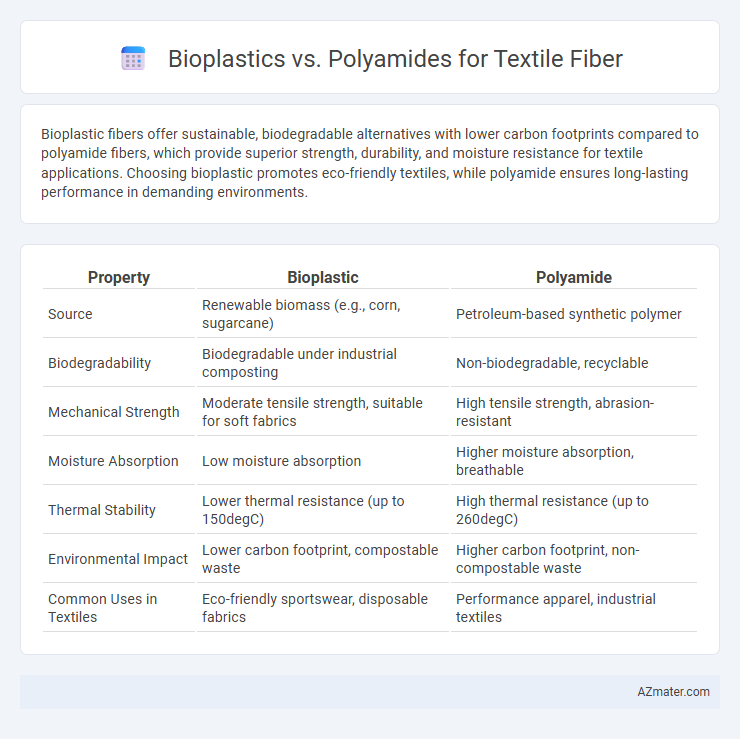Bioplastic fibers offer sustainable, biodegradable alternatives with lower carbon footprints compared to polyamide fibers, which provide superior strength, durability, and moisture resistance for textile applications. Choosing bioplastic promotes eco-friendly textiles, while polyamide ensures long-lasting performance in demanding environments.
Table of Comparison
| Property | Bioplastic | Polyamide |
|---|---|---|
| Source | Renewable biomass (e.g., corn, sugarcane) | Petroleum-based synthetic polymer |
| Biodegradability | Biodegradable under industrial composting | Non-biodegradable, recyclable |
| Mechanical Strength | Moderate tensile strength, suitable for soft fabrics | High tensile strength, abrasion-resistant |
| Moisture Absorption | Low moisture absorption | Higher moisture absorption, breathable |
| Thermal Stability | Lower thermal resistance (up to 150degC) | High thermal resistance (up to 260degC) |
| Environmental Impact | Lower carbon footprint, compostable waste | Higher carbon footprint, non-compostable waste |
| Common Uses in Textiles | Eco-friendly sportswear, disposable fabrics | Performance apparel, industrial textiles |
Overview of Bioplastic and Polyamide Fibers
Bioplastic fibers, derived from renewable biomass sources such as corn starch or sugarcane, offer biodegradable and eco-friendly alternatives to traditional synthetic fibers. Polyamide fibers, commonly known as nylon, are synthetic polymers characterized by their high strength, elasticity, and resistance to abrasion, widely used in high-performance textiles. Both materials serve distinct functions in the textile industry, with bioplastics prioritizing sustainability and polyamides delivering durability and functionality.
Material Sources and Manufacturing Processes
Bioplastic fibers, derived from renewable plant-based sources such as corn starch or sugarcane, offer a more sustainable alternative to conventional polyamide fibers, which are synthesized from petroleum-based chemicals through complex polymerization processes. The manufacturing of bioplastic fibers involves fermentation and extrusion techniques that reduce carbon footprint and reliance on fossil fuels, whereas polyamide fibers require energy-intensive processes including ring-opening polymerization and mold shaping. Material sourcing for bioplastics emphasizes biodegradability and resource renewability, contrasting with polyamide's dependence on finite petrochemical resources and associated environmental impacts.
Mechanical Properties and Durability
Bioplastic fibers exhibit superior biodegradability compared to polyamide, offering moderate tensile strength but reduced elasticity, which influences their durability under repeated stress. Polyamide fibers demonstrate high tensile strength, excellent abrasion resistance, and elastic recovery, making them more resilient in demanding textile applications. The mechanical properties of polyamide contribute to longer-lasting textiles, while bioplastic fibers prioritize environmental sustainability with trade-offs in durability.
Environmental Impact and Sustainability
Bioplastic fibers, derived from renewable resources such as corn starch or sugarcane, offer significant reductions in carbon footprint and biodegradability compared to conventional polyamide fibers, which are petroleum-based and contribute to microplastic pollution. Polyamide fibers, while durable and recyclable, require high energy consumption during production and release nitrous oxide, a potent greenhouse gas, impacting overall sustainability. Choosing bioplastic textile fibers supports circular economy principles by minimizing non-renewable resource dependence and enhancing end-of-life compostability, making them a more environmentally sustainable option.
Biodegradability and End-of-Life Options
Bioplastic textile fibers offer enhanced biodegradability compared to polyamide fibers, enabling more environmentally friendly disposal through composting or biodegradation in controlled industrial settings. Polyamide fibers, primarily derived from petroleum, exhibit limited biodegradability and often persist in landfills or marine environments, contributing to long-term environmental pollution. End-of-life options for bioplastic fibers include industrial composting and recycling programs, whereas polyamide fibers typically rely on mechanical recycling or energy recovery methods with higher environmental impact.
Cost Analysis and Market Availability
Bioplastic fibers generally have higher production costs compared to polyamide due to raw material expenses and limited large-scale manufacturing infrastructure. Polyamide fibers benefit from established supply chains and economies of scale, resulting in lower unit costs and widespread market availability. Despite rising demand for sustainable textiles, bioplastic fibers remain a niche market segment with constrained commercial penetration relative to polyamide.
Dyeability and Fabric Performance
Bioplastics used in textile fibers often exhibit limited dyeability due to their hydrophobic nature and lower affinity for conventional dyes, requiring specialized dyeing processes to achieve vibrant colors. Polyamide fibers, known for their excellent dye affinity and uniform color absorption, provide superior colorfastness and a wide palette of dye options, enhancing fabric aesthetics. In terms of fabric performance, polyamides offer high tensile strength, elasticity, and abrasion resistance, whereas bioplastics generally provide better biodegradability but may lack comparable mechanical durability and moisture management.
Applications in the Textile Industry
Bioplastic fibers, derived from renewable resources like corn starch and sugarcane, offer sustainable alternatives to traditional polyamide fibers, which are petroleum-based and known for their high strength, elasticity, and abrasion resistance. In the textile industry, bioplastics are increasingly utilized in eco-friendly activewear, casual apparel, and biodegradable nonwovens, while polyamide remains dominant in performance textiles such as sportswear, swimwear, and technical fabrics requiring durability and moisture-wicking properties. The choice between bioplastic and polyamide fibers depends on the balance between sustainability goals and functional performance requirements in textile applications.
Consumer Perception and Market Trends
Bioplastic fibers, derived from renewable sources like corn starch and sugarcane, are gaining consumer preference due to their sustainability and eco-friendly attributes, contrasting with polyamide fibers traditionally valued for durability and performance. Market trends show a rising demand for bioplastics in textiles driven by increasing environmental awareness and regulations promoting biodegradable materials. Polyamide maintains a strong market presence in high-performance and technical textiles, but shifts towards bioplastic fibers indicate a growing consumer and industry shift towards circular economy principles.
Future Prospects and Innovations
Bioplastic fibers, derived from renewable sources such as PLA and PHA, offer promising sustainability advantages over traditional polyamide fibers, which are petroleum-based and associated with higher environmental impact. Innovations in bioplastic fiber technology aim to enhance mechanical strength, durability, and biodegradability, positioning them as viable alternatives in high-performance textile applications. Future prospects include the integration of bio-based nanomaterials and enzymatic recycling methods, which could accelerate adoption and reduce the carbon footprint of textile manufacturing.

Infographic: Bioplastic vs Polyamide for Textile Fiber
 azmater.com
azmater.com